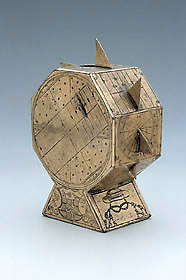
 |
| Catalogue |
 |
 Polyhedral Dial On the top face is a horizontal dial for hours 6 to12 to 6 and a circular hole with a pin support for a compass (the magnetic needle and glazed cover are absent). The gnomon is for latitude 52 degrees. On the adjacent face to the south, set at right angled to the equatorial plane, is an upper polar dial, with hour lines 9 to 12 to 3. On the face opposite to this is an inferior polar dial, with lines marked 4, 6 and 8. On the adjacent face to the north of the horizontal dial, set parallel to the equatorial plane, is an upper equinoctial dial, with hour lines 3 to 12 to 9. On the face opposite to this is an inferior equinoctial dial, with hour lines 4 to 12 to 5. Vertical north and south dials are on the two vertical rectangles. Each octagonal face has a projection of the celestial sphere with the horizon, pole, equator, tropics, arctic and antarctic circles marked. Between the tropics are the hour lines for east and west vertical dials with hour lines 3 to 11 and 1 to 9 respectively; the remainder of the projections are dotted with stars. Each dial is arranged for 52 degrees north See L. Evans, "On a Portable Sundial of Gilt Brass made for Cardinal Wolsey", Archaeologia, 57 (1901). Jim Bennett |



